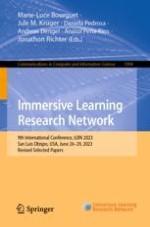This volume constitutes the refereed proceedings of the 9th International Conference of the Immersive Learning Network, iLRN 2023, held in San Luis Obispo, USA, in June 2023 as a hybrid event.
The 26 revised full papers and 13 shprt papers presented in this volume were carefully reviewed and selected from 110 submissions. The papers are organized in topical sections on foundations in immersive learning research and theory; assessment and evaluation; galleries, libraries, archives and museums; inclusion, diversity, equity, access, and social justice; STEM education; language, culture and heritage; nature & environmental sciences; workforce development & industry training; self and co-regulated learning with immersive learning environments; special track: immersive learning across Latin America: state of research, use cases and projects.
